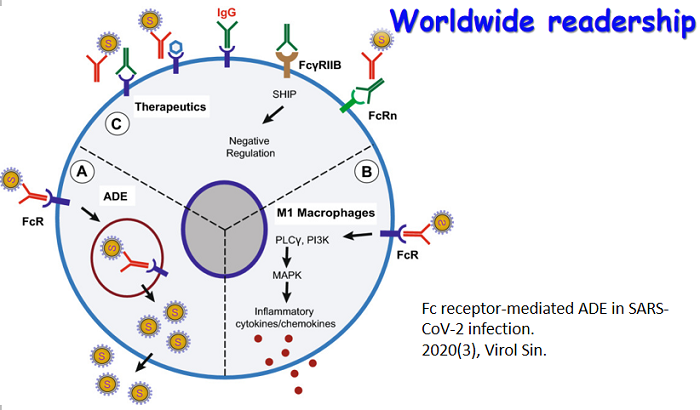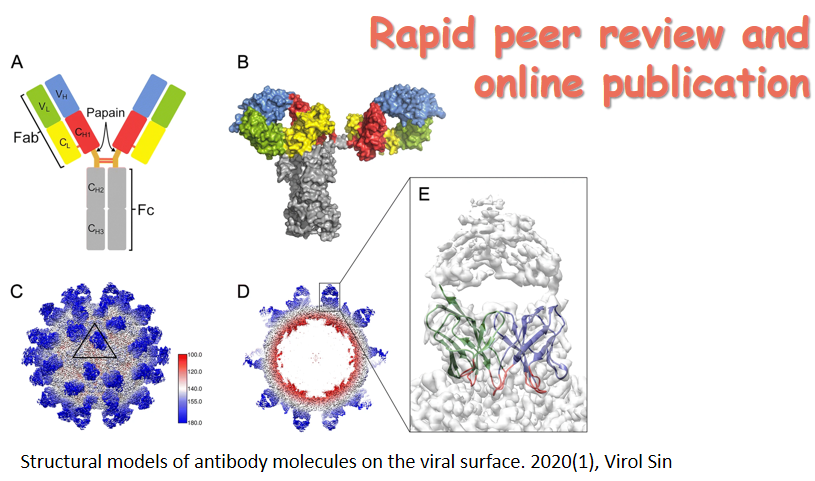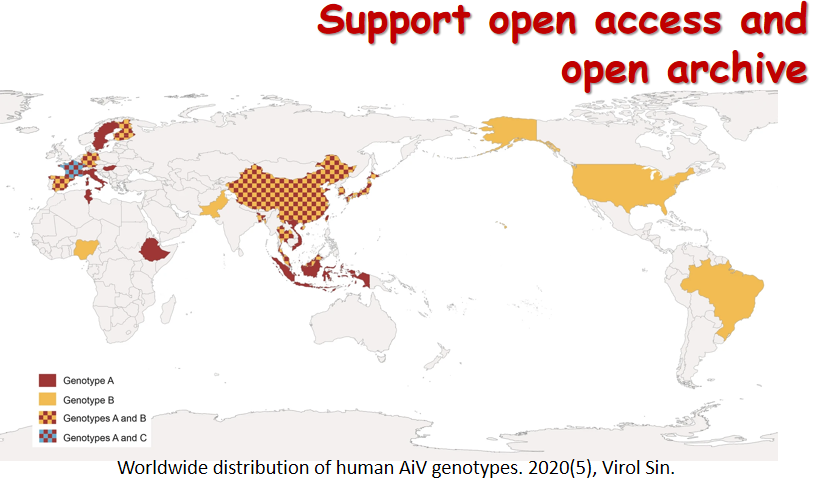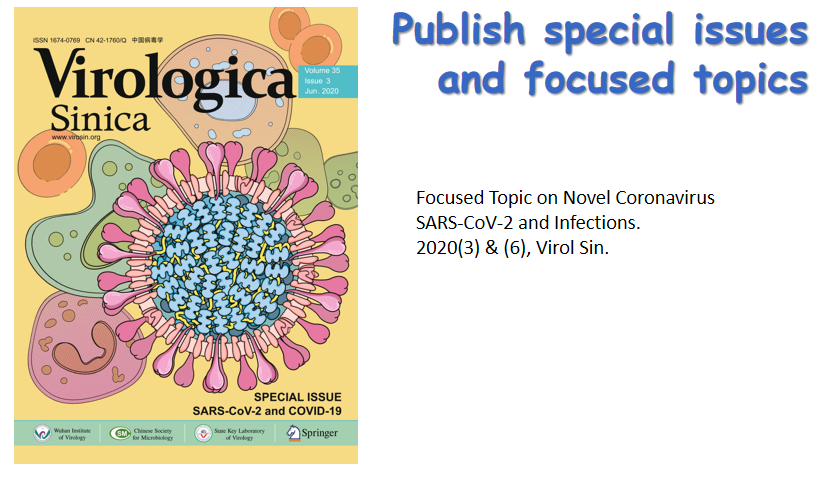|
Coding sequences of Transfusion transmiffed virus(TT virus or TTV) ORF2 was amplified by PCR, using plasmid pET-His-TTV2 containing the full-length ORF2 of TTV as template. The amplified fragment of 606bp was cloned into plasmid pEGFP-N1 and GFP-VP2 fusion protein was expressed. The recombinant plasmid pEGFPTTV2 was identified by restriction enzyme analysis and PCR. The pEGFPTTV2 was transfected into Cos7 cell line using LipoFectamine 2000, and the transcription products of TTV ORF2 gene in the transfected cells were confirmed by RT-PCR. Localization of the fusion protein was detected by confocal microscope, using PI to visualize the nuclear DNA. The result showed that VP2 was localized in cytoplasm and the inner nuclear membrane. Thus, VP2, as a non- structure protein, may play a role during DNA replication or transcription of TT virus.
Abstract:To analyze the diferent expression proteins of MT4 cells infected witl1 HIV 1 IIIB strain.The proteins of MT4 cells from infected and Uninfected HIV 1 IIIB were separated bv 2DE and the gels were an alyzed with software Image Master 2D Elite 3.01 to find out the diferent spots.The proteins in the spots were identified by matrix associated laser desorption/ionization time.of-flight(MALDI.TOF) mass spectrometry.A total of 40 diferent protein spots were found.1 2 proteins were down-regulated in the M T4 cells after infection;the other 28 proteins were up.regulated.29 proteins were detected bv M ALDI—T0E Th e proteins that down.regulated in MT4 cells after infecteion include proteins related to energy metabolism,actin proteins an d hypothetical proteins.The up—regulated proteins in MT4 cells after infecteion include proteins related to actin proteins,enzymes.immune proteins an d hypothetical proteins.In the M T4 cells infected bv HI man y proteins were chan ged.In order to understand the mechanism of infection of HIV,we must wipe Of the abundan t proteins an d study the proteins witl1 special functions.
In order to provide some data for the study on T cell epitopes of Hantaan virus nucleocapsid protein, we constructed EBV-transformed B lymphoblastoid cell line (BLCL) from HFRS patients’ PBMC. We inserted HTNV S and 5’ and 3’terminals of S gene segment into a eukaryotic expression vector pcDNA 3.1/V5-His TOPO. The recombinant expression plasmids pcDNA3.1-S and pcDNA 3.1-S-N pcDNA3.1-S-C were constructed. BLCL were transfected in vitro with them, selected by G418 and used as target cells for CTL cytotoxicity assay. The expression of HTNV S and 5’ and 3’terminals of S gene segment in BLCL was detected by indirect immunofluorescence assay (IFA). These recombinant plasmids can be expressed efficiently and steadily in BLCL. We can provide a tool for the study on T cell eptitopes of Hantaan virus nucleocapsid protein. The CTL clone recognized and killed the target cells with specificities of HTNV-NP. Cytotoxicities(%) were 50.2%, 39.0% and 25.4%, respectively. HTNV T cell antigenic epitopes were mainly localized on the C-terminal of the virus nucleocapsid protein.
In order to analyze the gene characterization of Human immunodeficiency virus-1(HIV-1) prevalence in Henan Province, a HIV-1 strain, named CNHN24, was isolated from one HIV-1 infected blood donor. The proviral DNA was extracted from productively infected PBMCs (peripheral blood mononuclear cells) and full-length HIV-1 genomes were amplified. The sequences were determined by Walking sequencing. All of the reading frames were compared with HIV-1 RL42 and HIV-1 HXB2. The secondary structure prediction of the envelope proteins of HIV-1 CNHN24 and RL42 were performed by Anthewin software. Multiple alignments of the whole genome, env and V3 loop gene with domestic HIV-1 strains and standard representatives of HIV-1 were performed by Clustal software package, and phylogenetic tree were constructed. The results showed that the HIV-1 CNHN24 was B′subtype (according to V3 nucleotide sequence). There were more purines in the HIV-1 CNHN24 genome, it was 60.24%. Compared with HIV-1 RL42 and HXB2, the homegeneity of gag and pol reading frames was higher, env and non- structural genes was lower. The envelope proteins secondary structure of CNHN24 and RL4 were homoplastic, but the amino acid variability was higher in conservative C4. Phylogenetic trees showed the closest relationship between CNHN24 and RL42, the next was between HIV-1 Lai and HIV-1 HXB2. HIV-1 V3 sequence phylogenetic tree also indicated the closest relationship of CNHN24 to CR206 and RL42, which were isolated in Yunnan Province. We inferred that the HIV-1 CNHN24 may derive from Yunnan Province.
To understand the characteristics of the ns1 gene of Avian influenza A virus H5N1 and to prepare NS1 protein in scale, viruses were cultivated in embryonated hen eggs and virion RNA was extracted from allantoic fluid. The complete ns gene was amplified by RT-PCR and analyzed. Sequence analysis demonstrated that the NS1 cDNA contained one open reading frame of 678 bp, which encoded a polypeptide of 225 amino acids. The ns1 gene of Qa/ST/852/01 (H5N1) isolate was closer to that of some H5N1 strains prevalent in southern China in recent years, the homologies of nucleotide and amino acid sequences were 99.0%~97.5% and 99.1%~97.8%, respectively. Subsequently, ns1 cDNA was obtained by PCR and cloned into pGEX-4T-3 vector to construct recombinant plasmid pGEX-4T-3/NS1 cDNA, and expressed in BL21(DE3) E.coli strain. SDS-PAGE and scan analysis showed recombinant fusion protein GST-NS1 was expressed in soluble form, and fusion protein amounted to 28.5% of the total soluble bacterial protein. The protein was purified by affinity chromatography and the purity was greater than 96%. Western blot analysis of recombinant fusion protein confirmed it could be specifically recognized by antibody of GST. Construction of the prokaryotic expression vector provided a foundation for further studying the function of NS1 protein and preparation of NS1 antibody.
According to the published genomic sequence of Porcine circovirus(PCV2), a pair of specific primers was designed to amplify the complete genome of PCV2 from tissues of piglets with PMWS. Five complete genomes of PCV2, named Fujian PCV, Guangxi PCV, Hainan PCV, Hunan PCV and Shandong PCV, were amplified and cloned into pMD 18-T vector, respectively. The genomes of PCV2 isolates showed that four of them were 1767bp in length, one genome, FujianPCV was 1768bp. The five sequences were compared with other published genomes of PCVs by DNAstar. The results showed that the sequences of the five isolates were closely related to those of other PCV2 isolates in the Genbank, homology were 93% to 98.8%. However, there were only 68.4% to 70% nucleotide identity with the PCV1 isolates. The amino acid sequences of ORF1 and ORF2 of the isolates showed high identities, from 98.1% to 99.4% and 88% to 99.1%.
A pair of primers was used in cloning and sequence analysis of vp4 gene from Porcine rotavirus JL94 isolated in China. According to the idea that 5’ segments of VP4 (1bp~750bp) principally control the activity of vp4 gene, a pair of another primers was used in cloning and obtained major antigen sites. The gene was cloned into the expression plasmid pGEX-6P-1. The recombinant plasmid VP4-pGEX-6P-1 was transformed into E. coli BL21(DE3)plays and induced with IPTG. Homology of amino acids between CRW-8 strain and BEN-307 strain is 96.98% and 98.05% respectively. The product of the VP4 gene was 26% of total bacterial protein of BL21. Western blot test and neutralization test circumstantiate the protein of expression has biological activity.
According to the published genomic sequences of Porcine reproductive and respiratory disease syndrome virus (PRRSV),Porcine parvovirus (PPV) and Porcine circovirus type 2, primers were designed and RT-PCR, PCR and multiplex PCR were set up for the detection of PRRSV, PPV and PCV, respectively. 127 samples were detected for PCV by the multiplex PCR. With the established methods, 67 clinical samples positive for porcine circovirus type 2 (PCV2) were tested for the presence of PRRSV and PPV. The results demonstrated that the co-infection rate of PRRSV/PCV2, PPV/PCV2 and PRRSV/PPV/PCV2 were detected in 52.3% (35/67), 26.9% (18/67) and 7.5% (5/67), respectively. The data obtained in the present study indicated that it is very prevalent for the co-infection of PRRSV, PPV and PCV2.
To study the interaction among Jembrana disease virus, Bovine immunodeficiency virus, Bovine Foamy Virus and Bovine Leukemia Virus, a series of plasmids were constructed with their LTR and luc report gene, respectively, and transactivator expression plasmids of these four viruses were also constructed. These plasmids were co-transfected into BL12 cell line, respectively. Transient assay showed the interactivation between LTR and Tat of BIV and JDV, suggesting that they could be transactivated each other. In addition, BFV Tas could transactivate JDV LTR and JDV Tat could transactivate BLV LTR whereas BLV Tax had no effect on JDV LTR and no other interactivation was detected among BLV, BFV and BIV.
According to the nucleotide sequence of Porcine reproductive and respiratory syndrome virus (PRRSV), two pairs of primers were designed and used to amplified the orf7 and orf5 genes by RT-PCR, respectively. By using the EcoRI、SpeI and Hind Ⅲ sites, both genes were cloned into pMD-18T vector in turn, then sequencing and comparing the homologies of the cloning genes. The combined orf7 and orf5 genes was subcloned into a prokaryotic expressing vector pGEX-KG, the recombinant plasmid named pGEX-KGNE was constructed and transformed into E.coli BL21.The results of SDS-PAGE and Western-blot indicated that the combined genes of orf7 and orf5 and Glutathion-S-transferase (GST) was expressed in E.coli BL21 as a fusion protein GST-NE about 64kDa in molecular weight, and this fusion protein showed reactive activity immunologically. This study lays a foundation for the development of the serodiagnostic methods and vaccines for PRRSV.
Spike (S) gene of Canine coronavirus giant panda’s isolate (CCV strain DXMV) was amplified and cloned into pGEM-T for sequencing. The complete length of spike gene of strain DXMV was 4362 bp, which encoded 1453 amino acids. The initiative 18 amino acids were signal peptide. The homologies of nucleic acid and amino acid of spike among strains of CCV were 40.2-99.5% and 15.9-99.0%, respectively. The variation mainly exist in front half second region of S gene, especially in the regions of 350-370, 439-478 and 1718-1818 nucleotide acids, while the region 1060-1700 nucleotide acids shows high conservative. Phylogenetic tree based on S gene and deduced amino acid sequence of 12 different strains of CCV showed that strain DXMV had closer relationships with wild strain K378,NVSL and US patent. There are 34 N-glycosylation sites in deduced S protein of strain DXMV and V54, but 33 for strain Insavc-l. Noticeably, the potential glycosylation site 566-568 was owned by DXMV and most virulent strains but not for weak virulent strains. Moreover, there were some differences in the hydrophobicity and antigenic index between DXMV and other strains of CCV. The effects of the differences in S protein on pathogenicity and immunogenicity should be further studied.
One pair of primers was designed and synthesized based on the Haemagglutinin (H) protein gene Sequercein the Onderstepoort strain of Canine distemper virus(CDV). The templates were produced from the reverse transcription reaction, total RNA was isolated from the Vero cells infected with the Nanjing isolate of CDV (CDV NJ-15). The full-length H gene fragment was amplified by polymerase chain reaction (PCR). Digested with EcoR I and Sal I, a 1058bp fragment of the PCR product was cloned into the expression plasmid vector pET-28b (+).The recombinant was transformed into the RosettaTM and induced to express by 1.0m mol/L IPTG at 37℃.The expression product was identified by SDS-PAGE and found to be 38kDa as expected and confirmed by Western blotting with CDV-Onderstepoort rabbit antiserum. The results revealed that the expressed fusion protein in vitro had the critical antigenitic epitopes of H gene of CDV.
A strain of avian influenza virus was isolated from lung tissue in 2004. It was determined to be a Avian influenza virus by ELISA and electron microscopy. HA and NA gene was amplified by RT-PCR and sequenced. By the analyses of HA and NA gene sequences, the isolate was an H5N1 subtype of avian influenza virus (A/Chicken/Yichang/Lung-1/04(H5N1)).
According to the Granulin gene’s 12 highly conservative nucleotides (TATAAGGAATTT) upstream from the protein intiation codon and the sequence of the Pieris brassiae granulovirus (PbGV) granulin gene, primers were designed to amplify the Pieris rapae granulosis virus (PrGV) granulin gene. The product of PCR amplification was about 850bp. The result of sequencing the segment showed the complete nucleotide sequence of the segment was 855bp. The segment contained one ORF encoding PrGV granulin gene which starts at position 38~40 and ends at position 779~781. The length of the ORF is 744bp and the length of predicted protein is 247 amino acid with MW of about 2.9178×104D. Comparison of the identities with other granulosis virus granulin gene showed the granulin gene is highly conserved in granulosis virus. The PrGV granulin gene was inserted into an exprssion vector, PET-28a, to yield the recombinant expression plasmid pet-28a-Gran. After induction by IPTG, the result of SDS-PAGE showed the expression of PrGV granulin in E. coli was obtained.
Autographa californica nucleopolyhedrovirus (AcMNPV) is the typical member of nucleopolyhedrovirus of Baculoviradae, a circled and double stranded large DNA virus. It’s also one of the most widely studied baculoviruses that turns out to be environment sound pesticide and a powerful vector of foreign protein expression as well as a promising vector of gene therapy. Revealing the molecular mechanism of the interaction plays a key role in the better understanding of viral replication, package, transportation and application of baculovirus as a gene therapy vector. Sequence analysis found that the P78/83 product of AcMNPV ORF9 shares the common motifs with WASP proteins indicating that P78/83 might involve in baculovirus transportation. Trying to understand P78/83 function, we constructed a recombinant virus vAc-orf9-gfp with the Bac-to-Bac system, within which AcMNPV ORF9 was fused with enhanced green fluorescence protein (EGFP). Sf21 cells were infected with the recombinant virus and Laser Confocal Microscopy was used to determine the subcellular location of P78/83. Green fluorescences showed major distribution in cell plasm a after 12h infection, and transfered into nucleus at 24 hpi. This means that P78/83 is located in the nucleus. Infection assay in vitro showed that overexpression of P78/83 had no effect on virus growth and viral assembly.
Genomic DNA of Orgyia ericae single-nucleocapsid nucleopolyhedrovirus (OrerSNPV) was digested with the restriction enzyme EcoRI and the fragments were cloned into the plasmid pUC19 to build a library for sequencing. An ORF encoding the LEF-2 was identified from the cloned EcoRI-M (3.0kb)and EcoRI-P(2.2kb)fragments with 648 bp in length and potential to encode a 216 amino acid polypeptide with predicted molecular weight of 23.7 kD. In addition, two ORFs encoding the partial LEF-3 and LEF-11 were identified from two ends of the cloned EcoRI-E (about 10 kb). Comparison analysis showed that OrerSNPV LEF-2 amino acid sequence shared 35%-49% identities with those of other 27 reported lepidopteran NPV LEF-2s, and the highest identities with BusuSNPV, MacoNPV-A, Helicoverpa zea single-nucleocapsid nucleopolyhedrovirus (HezeSNPV), Helicoverpa armigera single- nucleocapsid nucleopolyhedrovirus (HearSNPV) and Lymantria dispar multiple-nucleocapsid nucleopoly- hedrovirus (LdMNPV). OrerSNPV LEF-2 also shared 26%-31%, 32% and 23% identities with those from lepidopteran GVs, the hymenopteran NPV (Neodiprion sertifer nucleopolyhedrovirus, NeseNPV) and the dipteran virus (Culex nigripalpus Baculovirus). Phylogenetic tree based on the amino acid sequences showed the 28 baculovirus LEF-2s could be divided into 4 branches, NPVs, GVs, NeseNPV and Culex nigripalpus Baculovirus. OrerSNPV lef-2 gene was most closely related to Buzura suppressaria single- nucleocapsid nucleopolyhedrovirus (BusuSNPV), while OrerSNPV was most closely related to LdMNPV in the phylogenetic tree based on LEF-3 sequences and to Spodoptera exigua multiple- nucleocapsid nucleopolyhedrovirus (SeMNPV) in the tree of LEF-11. EMBL Accession numbers for the nucleotide sequences of the lef-2, lef-3 and lef-11 are AJ629189, AJ715478 and AJ715479, respectively.
The fragment of plasmid pCMV-tag-2B excluding Cytomegalovirus(CMV) promoter sequence was obtained by restriction enzyme digestion. A pair of primers was synthesized to amplify a fragment of the H1 promoter according to reference. The fragment of H1 promoter was amplified and inserted into the fragment of plasmid pCMV-tag-2B excluding CMV promoter sequence and plasmid pGEM- 11fz, respectively. The recombinant plasmids were named pCH1 and pGH1. A pair of primers, which included small interfering RNA(siRNA)target site for mRNA of EGFP gene, was synthesized and annealed in vitro, and then inserted into the corresponding vectors pCH1 and pGH1. In addition, the plasmid pEGFP-N3 expressing EGFP protein was transfected into liver tumor line Bel-7402 alone, or in combination with the plasmids producing siRNA to degrade mRNA of EGFP gene. The expression level of EGFP protein was viewed under the microscope. The results indicated that the plasmids including siRNA target site for mRNA of EGFP gene produced siRNA molecular and degraded mRNA of EGFP gene. The vector, PCH and pGH, will be used to study prevention of virus in fection.
Using a pair of specific primers designed according to the relevant nucleotide sequence of Porcine Reproductive and Respiratory Syndrome Virus(PRRSV)VL2332 strain, Lv strain and Classical Swine Fever Virus(CSFV) C strain from GenBank, RT-PCR method was established to detect these two viruses at the same time. With this method, 87 tissue samples of 24 pig farms from Jiangsu, Shanghai and Fujian were tested. Among these samples 75 were PRRS positive, 56 were CSF positive, 53 were both PRRS and CSF positive, which amounts to 60.9 percent of all samples. Combined with regional epidemiology analysis, We concluded that samples from Fujian mainly mixed infected with PRRSV and CSFV, but samples from Jiansu simply infected with PRRSV.
To investigate HIV genotypes isolated from blood donors in Beijing, the samples positive for anti-HIV antibody with ELISA were confirmed by HIV blot. All 26 samples were confirmed positive for anti-HIV antibody. RNA from those samples were detected with RT-PCR. 20 of them were positive for HIV RNA. The purified PCR products were cloned. The sequences were determined and analyzed. The results showed that 10 of 20 isolates were CRF BC, 9 of them were genotype B, 1 of them were CRF AE. 6 of 9 genotype B belong to B’(Thailand B), the remaining 3 isolates may belong to western genotype B. The results indicated that several different genotypes of HIV which are predominant in China may exist in Beijing. This result may be helpful for the development of HIV vaccine in Beijing.
In order to explore the relationship between Hepatitis B virus infection(HBV) and hepatocellular carcinoma (HCC), a case-control study was conducted based on the diagnosed HCC patients in Wuhan city from January 1, 2000 to July 31, 2003. The data obtained from 313 cases and 313 controls were first analysed by means of single variable analysis and then by the multivariate Logistic regression analysis. The result showed that history of HBV infection was closely associated with HCC (OR=7.606, 95%CI 3.679-15.722). History of hepatitis is the major risk factors of HCC.
In this experiment the Fowlpox virus (FPV) antibody of two groups of chickens were tracked for 20 weeks by indirect enzyme-linked immunosorbent assay (ELISA). A group of chickens were artificial infected. B group were the control of healthy chickens. The results indicated that the positive antibody rate of A group reached 95% in 4 weeks. The high level antibody could last 10 weeks. After being infected again the positive antibody rate reached 100% in two weeks. The positive antibody rate of serum of some convalescent chickens infected naturally was 44%, and which of three groups from some farms that were vaccinated with pox vaccine were 60%, 70% and 10% respectively. The chickens whose antibody was proved negative changed from positive with the method were ill after they had been infected artificially. However none of the chickens whose antibody were positive suffered from the virus after they were infected artificially. In addition, the neutralization test shown the antibody of FPV might be used to treat pox disease.
















